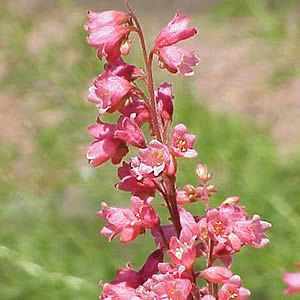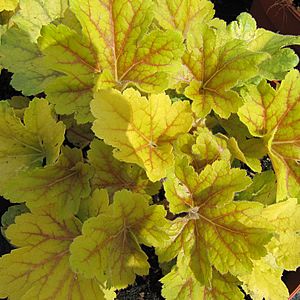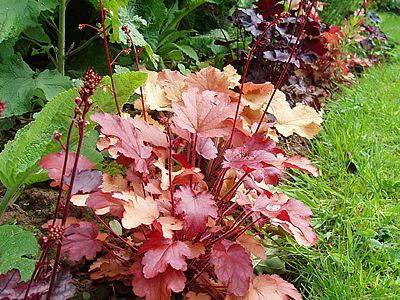The Heuchera sp are herbaceous plants with ornamental foliage and flowering, native to North America, where they are known as Coral Bells. They have a compact growth and are primarily notable for their showy, colorful foliage in various varieties, reminiscent of rex begonias and hostas. Their leaves emerge in rosettes, supported by long petioles, directly from the plant’s base, which has a woody rhizome.
The leaves are palmate and lobed, with a delicate, soft texture. They are hirsute and may exhibit interesting degradées, which change according to the light exposure. There are hundreds of cultivars and hybrids with different colors and shades of lemon-yellow, bronze, wine, pink, violet, red, chocolate, ochre yellow, and an infinity of greens. Beautiful variegations and veinings in colors distinct from the rest of the leaf also occur.
Flowering occurs in summer, producing tall inflorescences of the panicle type, with numerous bell-shaped flowers that can be pink, red, yellow, green, or white, depending on the variety. In some cultivars, the flowers take on the primary ornamental importance, with the foliage in the background. The flowers of the heuchera are long-lasting and can be used as cut flowers. They are also very attractive to hummingbirds, butterflies, and bees.

Coral Bells are very popular in landscaping in temperate climate countries, such as in Europe and North America, where they add vibrant colors and texture to mass plantings, borders, as well as in mixed beds, contrasting with other species and varieties. They are particularly useful in shaded areas, where it can be difficult to grow colorful plants.
In Oceania, Africa, and South America, they are still rare in cultivation, but can be successfully grown in regions with subtropical and high-altitude tropical climates. Besides coloring the garden, whether used as ground covers in full sun or partial shade, heucheras are also excellent foliage plants when grown in pots and planters, thus beautifying both outdoor and indoor environments.

They should be grown in full sun or partial shade, depending on the cultivar, in airy, well-drained soil rich in organic matter and watered regularly. Generally, varieties with light colors prefer more shaded locations, while those with strong red or purple pigmentation are prepared to withstand sunny beds. However, always check the specific needs of each cultivar at the time of purchase, ensuring the level of light preference for the plant in question.
Coral Bells suffer from intense heat, which can cause burns and wilting in their leaves. Fertilizing every three months keeps the leaves beautiful, and slow-release types are ideal. They are cold-resistant in subtropical to temperate climates. Encourage new blooms in the same season by removing old inflorescences from plants that have already flowered.
Renew their foliage annually with a more drastic pruning, carried out at the beginning of spring, thus removing leaves damaged by winter and illuminating new leaves emerging from the base of the plant. They can be propagated by dividing the clumps and by seeds.


